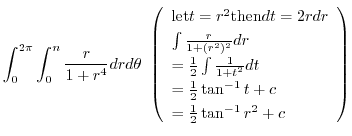Next: Application of double integrals Up: MULTIPLE INTEGRATION Previous: Improper integrals 索引
7.4
1.


 is not defined at
is not defined at  . Thus we let
. Thus we let

 |
 |
 |
|
 |
![$\displaystyle \lim_{\varepsilon \to 0}[\sin^{-1}{x}{y}]_{0}^{y - \varepsilon} = \frac{\pi}{2}$](img756.png) |

(b)
 is not bounded. Thus we consider
is not bounded. Thus we consider

 , we have
, we have
 |
 |
 |
|
 |
![$\displaystyle \int_{0}^{n}\left[-e^{-(x+y)}\right]_{0}^{n} \ dx$](img763.png) |
||
 |
![$\displaystyle \int_{0}^{n}(-e^{(x+n)} + e^{-x})dx = \left[e^{-(x+n)} + e^{-x}\right]_{0}^{n}$](img764.png) |
||
 |
 |

 is bounded.
is bounded.
 is bounded on
is bounded on
 .Thus we consider
.Thus we consider

 ,
,


 |
 |
 |
|
 |
 |
||
 |
 |
||
 |
 |
||
 |
![$\displaystyle \left[\frac{\theta^2}{2}\right]_{0}^{\frac{\pi}{2}}\left[\frac{r^...
...\right]_{\frac{\sqrt{2}}{n}}^{1} = \frac{\pi^2}{8}(\frac{1}{2} - \frac{1}{n^2})$](img777.png) |

(d)
 is not bounded. Thus we consider
is not bounded. Thus we consider

 , we have
, we have
 |
 |
 |
|
 |
![$\displaystyle \int_{1}^{n}\left[-\frac{1}{x^2 y}\right]_{1}^{n} \ dx$](img782.png) |
||
 |
![$\displaystyle \int_{1}^{n}(\frac{1}{x^2} - \frac{1}{x^2 n})dx = \left[-\frac{1}{x} + \frac{1}{xn}\right]_{1}^{n}$](img783.png) |
||
 |
 |

(e)
 is not defined on the curve
is not defined on the curve  .Then we let
.Then we let
 be the set of
be the set of  plane except
plane except
 .Now using H-simple, we hae
.Now using H-simple, we hae

 ,
,
 |
 |
 |
|
 |
![$\displaystyle \int_{-\sqrt{1 - \frac{1}{n}}}^{\sqrt{1 - \frac{1}{n}}}\left[2\sqrt{x - y^2}\right]_{y^2 + \frac{1}{n}}^{1} \ dy$](img792.png) |
||
 |
 ere ere |
||
 |
![$\displaystyle 2(\frac{1}{2}) \left[\sqrt{1 - y^2} + \sin^{-1}{y} - \sqrt{\frac{1}{n}} y\right]_{-\sqrt{1 - \frac{1}{n}}}^{\sqrt{1 - \frac{1}{n}}}$](img795.png) |
||
 |
 |

(f)
 is not bouned. Then we consier
is not bouned. Then we consier

 .Using the polarcoordinates,
.Using the polarcoordinates,

 |
 |
 |
|
 |
 |
||
 |
![$\displaystyle \int_{0}^{2\pi} d\theta\left[\frac{1}{2}\tan^{-1}{r^2}\right]_{0}^{2\pi}$](img803.png) |
||
 |
 |

2.

 . Then
. Then

 implies
implies
